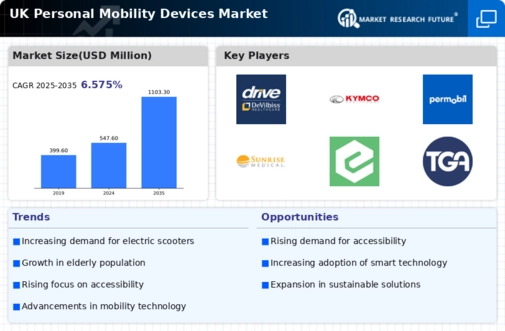The personal mobility-devices market is currently characterized by a dynamic competitive landscape, driven by innovation, sustainability, and technological advancements. Key players such as Segway (US), Xiaomi (CN), and Razor (US) are actively shaping the market through strategic initiatives. Segway (US) focuses on enhancing its product offerings with advanced features, while Xiaomi (CN) leverages its extensive ecosystem to integrate mobility devices with smart technology. Razor (US) emphasizes affordability and accessibility, appealing to a broader consumer base. Collectively, these strategies foster a competitive environment that prioritizes innovation and consumer engagement.
In terms of business tactics, companies are increasingly localizing manufacturing to mitigate supply chain disruptions and optimize costs. The market structure appears moderately fragmented, with several players vying for market share. This fragmentation allows for diverse offerings, yet the influence of major companies remains significant, as they set trends and standards that smaller firms often follow.
In October 2025, Segway (US) announced a partnership with a leading tech firm to develop AI-driven features for its scooters, aiming to enhance user experience and safety. This strategic move underscores Segway's commitment to innovation and positions it favorably against competitors. The integration of AI technology could potentially redefine user interaction with mobility devices, making them more intuitive and responsive.
In September 2025, Xiaomi (CN) launched a new line of electric scooters that incorporate smart connectivity features, allowing users to control their devices via a mobile app. This initiative not only aligns with Xiaomi's broader strategy of creating a connected ecosystem but also enhances user convenience and engagement. The introduction of such features may attract tech-savvy consumers, further solidifying Xiaomi's market position.
In August 2025, Razor (US) expanded its product line to include eco-friendly scooters made from sustainable materials. This move reflects a growing trend towards sustainability within the industry and caters to environmentally conscious consumers. By prioritizing eco-friendly practices, Razor (US) not only differentiates itself but also aligns with global sustainability goals, potentially increasing its appeal in a competitive market.
As of November 2025, the personal mobility-devices market is witnessing trends such as digitalization, sustainability, and the integration of AI technologies. Strategic alliances are becoming increasingly important, as companies collaborate to enhance their technological capabilities and market reach. Looking ahead, competitive differentiation is likely to evolve from traditional price-based competition to a focus on innovation, technology integration, and supply chain reliability. This shift suggests that companies that prioritize these aspects will be better positioned to thrive in an increasingly competitive landscape.





















Leave a Comment